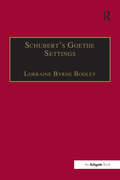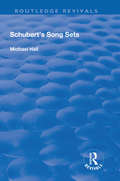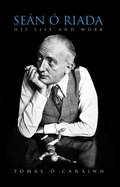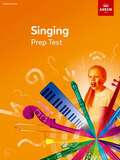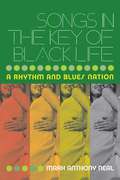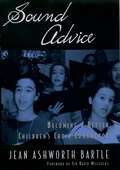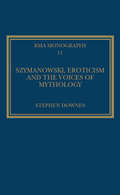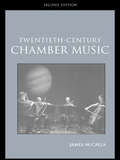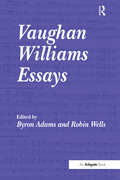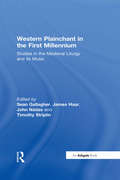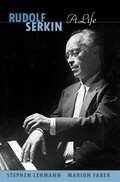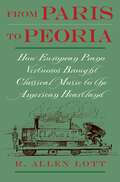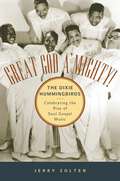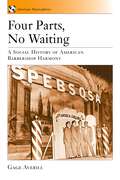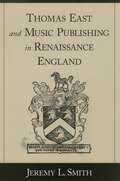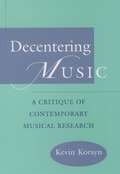- Table View
- List View
Schubert's Goethe Settings
by LorraineByrne BodleyThe traditional approach to the study of Goethe and Schubert is to place them in opposition to one another, both in terms of their life experiences and in relation to the nineteenth-century Lied. In her introduction to this book, Lorraine Byrne examines the myths that have evolved around these artists and challenges the view that Goethe was unmusical and conservative in his musical tastes. She also considers Schubert's life in relation to his obvious affinity with the poet and links the composer's Goethe settings with the poet's perception of the Lied. Goethe judged the success of a setting by whether the meaning of the text had been realised in musical form. In his Goethe settings Schubert translates the poet's meaning into musical terms and his rendition attains the classical unity of words and music that Goethe sought. The core of this volume is the series of individual analyses of all of Schubert's solo, dramatic and multi-voice settings of Goethe texts. These explore in detail both the literary and the musical dimensions of each work, and Schubert's reading and interpretation of Goethe's writings. This is the first study in English to treat both artists with equal attention and insight. This, together with its encyclopaedic coverage of this important corpus of works, makes this volume an essential reference tool for all those who study Schubert and Goethe.
Schubert's Goethe Settings
by LorraineByrne BodleyThe traditional approach to the study of Goethe and Schubert is to place them in opposition to one another, both in terms of their life experiences and in relation to the nineteenth-century Lied. In her introduction to this book, Lorraine Byrne examines the myths that have evolved around these artists and challenges the view that Goethe was unmusical and conservative in his musical tastes. She also considers Schubert's life in relation to his obvious affinity with the poet and links the composer's Goethe settings with the poet's perception of the Lied. Goethe judged the success of a setting by whether the meaning of the text had been realised in musical form. In his Goethe settings Schubert translates the poet's meaning into musical terms and his rendition attains the classical unity of words and music that Goethe sought. The core of this volume is the series of individual analyses of all of Schubert's solo, dramatic and multi-voice settings of Goethe texts. These explore in detail both the literary and the musical dimensions of each work, and Schubert's reading and interpretation of Goethe's writings. This is the first study in English to treat both artists with equal attention and insight. This, together with its encyclopaedic coverage of this important corpus of works, makes this volume an essential reference tool for all those who study Schubert and Goethe.
Schubert's Song Sets
by Michael HallThis title was first published in 2003. From 1821 until his death, Schubert compiled or specially composed for publication 42 song sets, yet during his own lifetime, and until now, their integrity and importance as sets have been virtually ignored. In this book, Michael Hall asserts that these songs sets are not arbitrary collections, as so often assumed, but highly integrated works in their own right. Approaching these songs as sets the book throws light on Schubert's largely undiscussed intellectual preoccupations. They reveal that he was au fait with most of the philosophical concerns of his time, especially those which touched on Romanticism. But although the sets reflect Romanticism in their topics, Hall maintains that they are the epitome of classical balance. In encouraging students and performers to approach these songs as sets, this study aims to alter perceptions of this important repertory.
Schubert's Song Sets
by Michael HallThis title was first published in 2003. From 1821 until his death, Schubert compiled or specially composed for publication 42 song sets, yet during his own lifetime, and until now, their integrity and importance as sets have been virtually ignored. In this book, Michael Hall asserts that these songs sets are not arbitrary collections, as so often assumed, but highly integrated works in their own right. Approaching these songs as sets the book throws light on Schubert's largely undiscussed intellectual preoccupations. They reveal that he was au fait with most of the philosophical concerns of his time, especially those which touched on Romanticism. But although the sets reflect Romanticism in their topics, Hall maintains that they are the epitome of classical balance. In encouraging students and performers to approach these songs as sets, this study aims to alter perceptions of this important repertory.
Seán Ó Riada: His Life and His Work
by Tomás Ó CannainImagine no Chieftains, no Planxty or Bothy Band, no Moving Hearts or Riverdance! This biography of Seán Ó Riada, who spearheaded the revival of Irish traditional music and moved it onto the international stage, shows it might not have happened without him. One of the few significant artists to remain in Ireland after the Second World War, he became an influential and intriguing character – composer, musician, raconteur, film-maker and academic. In this wide-ranging account of his life, his friend and colleague looks behind the mask to reveal the complex personality of a unique individual and paint a vivid picture of an ambivalent talent. In his short life, Ó Riada encountered a host of personalities and suffered personal, professional and financial crises. The result is a fund of anecdotes, many almost surreal. The book concludes with the highly amusing Charles Acton correspondence and the great critic’s obituary for Ó Riada. * Also available: An Poc Ar Buile by Seán Ó Sé
Singing Prep Test (ABRSM Prep Tests)
by AbrsmThe Singing Prep Test is designed to be taken by singers who have been learning for a few terms. It enables pupils to practise and demonstrate important musical skills, such as sense of pitch and rhythm, clear diction, accuracy and quality of tone. This book contains specially-commissioned pieces as well as everything else needed to take the test.
Songs in the Key of Black Life: A Rhythm and Blues Nation
by Mark Anthony NealFirst Published in 2003. Routledge is an imprint of Taylor & Francis, an informa company.
Songs in the Key of Black Life: A Rhythm and Blues Nation
by Mark Anthony NealFirst Published in 2003. Routledge is an imprint of Taylor & Francis, an informa company.
Sound Advice: Becoming a Better Children's Choir Conductor
by Jean Ashworth BartleSound Advice is a valuable resource for college students, beginning teachers, and experienced conductors of children's choirs. It covers the vast array of skills needed by today's conductor and will benefit all choir directors who want their choirs to reach a higher level of artistry. This book will be useful on many levels: for the college student studying the child voice and elementary teaching methods; for the teacher beginning to direct choirs in schools, synagogues, churches and communities; for experienced children's choir directors who wish to know more about orchestral repertoire for treble voices, conducting an orchestra, and preparing a children's choir to sing a major work with a professional orchestra. The underlying educational philosophy is sound; the author sees development of musicianship through singing as the primary goal of a children's choir program. This philosophy differs dramatically from the traditional concept of the conductor as all-knowing and the singers as receptacles. An outstanding aspect of the book is how the author leads the reader to an understanding of how to teach musicianship. Developing literacy in the choral setting is a mysterious, amorphous process to many conductors, but the author clearly outlines this important process with practical suggestions, well-documented examples, and a clear reading style which will reach readers on many levels. The comprehensive repertoire, skill-building sheets, and programs for all types of children's choirs will provide teachers with immediate and highly valuable resources.
Sounds in Space, Sounds in Time (PDF): Projects in listening, improvising and composing
by Richard VellaProjects in listening, improvising and composing for secondary school - college level students.
Szymanowski, Eroticism and the Voices of Mythology
by Stephen DownesThe desire to voice the artistic revelation of the truth of a precarious, multi-faceted, yet integrated self lies behind much of Szymanowski's work. This self is projected through the voices of deities who speak languages of love. The unifying figure is Eros, who may be embodied as Dionysus, Christ, Narcissus or Orpheus, and the gospel he proclaims tells of the resurrection and freedom of the desiring subject. This book examines Szymanowski's exploration of the relationship between the authorial voice, mythology and eroticism within the context of the crisis of the modern subject in Western culture. Stephen Downes analyses mythological and erotic aspects of selected songs from the composer's early career, moving to an interpretation of the voice of the homoerotic lover, embodied as a mad muezzin, in terms of heroic notions of Orphic elegy. Discussing the encounters of King Roger with the voices of Narcissus, the Siren and Dionysus, Downes shows how the composer uses the unifying Christ/Eros figure as a means of indicating that the King might be transformed from anguished despot to loving expressive subject. The book ends with an examination of Szymanowski's desire to fuse Slavonic and Middle-Eastern mythological inspirations in an attempt to fulfil a utopian vision of a pan-European culture bound together by the spirit of Eros.
Szymanowski, Eroticism and the Voices of Mythology
by Stephen DownesThe desire to voice the artistic revelation of the truth of a precarious, multi-faceted, yet integrated self lies behind much of Szymanowski's work. This self is projected through the voices of deities who speak languages of love. The unifying figure is Eros, who may be embodied as Dionysus, Christ, Narcissus or Orpheus, and the gospel he proclaims tells of the resurrection and freedom of the desiring subject. This book examines Szymanowski's exploration of the relationship between the authorial voice, mythology and eroticism within the context of the crisis of the modern subject in Western culture. Stephen Downes analyses mythological and erotic aspects of selected songs from the composer's early career, moving to an interpretation of the voice of the homoerotic lover, embodied as a mad muezzin, in terms of heroic notions of Orphic elegy. Discussing the encounters of King Roger with the voices of Narcissus, the Siren and Dionysus, Downes shows how the composer uses the unifying Christ/Eros figure as a means of indicating that the King might be transformed from anguished despot to loving expressive subject. The book ends with an examination of Szymanowski's desire to fuse Slavonic and Middle-Eastern mythological inspirations in an attempt to fulfil a utopian vision of a pan-European culture bound together by the spirit of Eros.
Twentieth-Century Chamber Music
by James McCallaFirst Published in 2003. Routledge is an imprint of Taylor & Francis, an informa company.
Twentieth-Century Chamber Music
by James McCallaFirst Published in 2003. Routledge is an imprint of Taylor & Francis, an informa company.
Vaughan Williams Essays
by Byron Adams Robin WellsSerious scholarship on the music of Ralph Vaughan Williams is currently enjoying a lively revival after a period of relative quiescence, and is only beginning to address the enduring affection of concert audiences for his music. The essays that comprise this volume extend the study of Vaughan Williams's music in new directions that will be of interest to scholars, performers and listeners alike. This volume contains the work of eleven North American scholars who have been recipients of the Ralph Vaughan Williams Fellowship based at the composer's own school, Charterhouse, which was created and has been supported by the Carthusian Trust since 1985. This wide-ranging and detailed collection of essays covers the spectrum of genres in which Vaughan Williams wrote, including dance, symphony, opera, song, hymnody and film music. The contributors also employ a range of analytical and historical methods of investigation to illuminate aspects of Vaughan Williams's compositional techniques and influences, musical, literary and visual.
Vaughan Williams Essays
by Robin WellsSerious scholarship on the music of Ralph Vaughan Williams is currently enjoying a lively revival after a period of relative quiescence, and is only beginning to address the enduring affection of concert audiences for his music. The essays that comprise this volume extend the study of Vaughan Williams's music in new directions that will be of interest to scholars, performers and listeners alike. This volume contains the work of eleven North American scholars who have been recipients of the Ralph Vaughan Williams Fellowship based at the composer's own school, Charterhouse, which was created and has been supported by the Carthusian Trust since 1985. This wide-ranging and detailed collection of essays covers the spectrum of genres in which Vaughan Williams wrote, including dance, symphony, opera, song, hymnody and film music. The contributors also employ a range of analytical and historical methods of investigation to illuminate aspects of Vaughan Williams's compositional techniques and influences, musical, literary and visual.
Western Plainchant in the First Millennium: Studies in the Medieval Liturgy and its Music
by Sean GallagherTaking up questions and issues in early chant studies, this volume of essays addresses some of the topics raised in James McKinnon's The Advent Project: The Later Seventh-Century Creation of the Roman Mass, the last book before his untimely death in February 1999. A distinguished group of chant scholars examine the formation of the liturgy, issues of theory and notation, and Carolingian and post-Carolingian chant. Special studies include the origins of musical notations, nuances of early chant performance (with accompanying CD), musical style and liturgical structure in the early Divine Office, and new sources for Old-Roman chant. Western Plainchant in the First Millenium offers new information and new insights about a period of crucial importance in the growth of the liturgy and music of the Western Church.
Western Plainchant in the First Millennium: Studies in the Medieval Liturgy and its Music
by Sean Gallagher; James Haar; John Nádas; Timothy StriplinTaking up questions and issues in early chant studies, this volume of essays addresses some of the topics raised in James McKinnon's The Advent Project: The Later Seventh-Century Creation of the Roman Mass, the last book before his untimely death in February 1999. A distinguished group of chant scholars examine the formation of the liturgy, issues of theory and notation, and Carolingian and post-Carolingian chant. Special studies include the origins of musical notations, nuances of early chant performance (with accompanying CD), musical style and liturgical structure in the early Divine Office, and new sources for Old-Roman chant. Western Plainchant in the First Millenium offers new information and new insights about a period of crucial importance in the growth of the liturgy and music of the Western Church.
Rudolf Serkin: A Life
by Stephen Lehmann Marion FaberThis book is the first biography of 20th-century pianist Rudolf Serkin, providing a narrative of Serkin's life with emphasis on his European roots and the impact of his move to America. Based on his personal papers and correspondence, as well as extensive interviews with friends, family, and colleagues, the authors focus on three key aspects of Serkin's work, particularly as it unfolded in America: his art and career as a pianist, his activities as a pedagogue, including his long association with the Curtis Institute in Philadelphia, and his key role in institutionalizing a redefinition of musical values in America through his work as artistic director of the Marlboro Music School and Festival in Vermont. A candid and colorful blend of narrative and interviews, it offers a probing look into the life and character of this very private man and powerful musical personality.
From Paris to Peoria: How European Piano Virtuosos Brought Classical Music to the American Heartland
by R. Allen LottIt's difficult to imagine Franz Liszt performing in Peoria, but his contemporary and foremost rival, Sigismund Thalberg, did just that. During the mid-nineteenth century, Americans in more than a hundred cities--from Portland, Maine to Dubuque, Iowa to Mobile, Alabama--were treated to performances by some of Europe's most celebrated pianists. From Paris to Peoria deftly chronicles the visits of five of these pianists to the America of Mark Twain. Whether performing in small railroad towns throughout the Midwest or in gold-rush era California, these five charismatic pianists--Leopold de Meyer, Henri Herz, Sigismund Thalberg, Anton Rubinstein, and Hans von Bülow--introduced many Americans to the delights of the concert hall. With humor and insight, R. Allen Lott describes the glamour and the drudgery of the touring life, the transformation of American audiences from boisterous to reverent, and the establishment of the piano recital as a viable artistic and financial enterprise. Lott also explores the creative and sometimes outlandish publicity techniques of managers seeking to capitalize on prosperous but uncharted American markets. The result of extensive archival research, From Paris to Peoria is richly illustrated with concert programs, handbills, caricatures, and maps. A companion website, www.rallenlott.info, includes a comprehensive list of repertoires and itineraries, audio music examples, and transcriptions of selected primary sources. Certain to delight pianists, musicologists, and historians, From Paris to Peoria is an engaging, thoroughly researched, and often funny account of music and culture in nineteenth-century America.
Great God A'Mighty! The Dixie Hummingbirds: Celebrating the Rise of Soul Gospel Music
by Jerry ZoltenFrom the Jim Crow world of 1920s Greenville, South Carolina, to Greenwich Village's Café Society in the '40s, to their 1974 Grammy-winning collaboration on "Loves Me Like a Rock," the Dixie Hummingbirds have been one of gospel's most durable and inspiring groups. Now, Jerry Zolten tells the Hummingbirds' fascinating story and with it the story of a changing music industry and a changing nation. When James Davis and his high-school friends starting singing together in a rural South Carolina church they could not have foreseen the road that was about to unfold before them. They began a ten-year jaunt of "wildcatting," traveling from town to town, working local radio stations, schools, and churches, struggling to make a name for themselves. By 1939 the a cappella singers were recording their four-part harmony spirituals on the prestigious Decca label. By 1942 they had moved north to Philadelphia and then New York where, backed by Lester Young's band, they regularly brought the house down at the city's first integrated nightclub, Café Society. From there the group rode a wave of popularity that would propel them to nation-wide tours, major record contracts, collaborations with Stevie Wonder and Paul Simon, and a career still vibrant today as they approach their seventy-fifth anniversary. Drawing generously on interviews with Hank Ballard, Otis Williams, and other artists who worked with the Hummingbirds, as well as with members James Davis, Ira Tucker, Howard Carroll, and many others, The Dixie Hummingbirds brings vividly to life the growth of a gospel group and of gospel music itself.
Four Parts, No Waiting: A Social History of American Barbershop Quartet (American Musicspheres #1)
by Gage AverillFour Parts, No Waiting investigates the role that vernacular, barbershop-style close harmony has played in American musical history, in American life, and in the American imagination. Starting with a discussion of the first craze for Austrian four-part close harmony in the 1830s, Averill traces the popularity of this musical form in minstrel shows, black recreational singing, vaudeville, early recordings, and in the barbershop revival of the 1930s. In his exploration of barbershop, Averill uncovers a rich musical tradition--a hybrid of black and white cultural forms, practiced by amateurs, and part of a mythologized vision of small-town American life. Barbershop harmony played a central -- and overlooked -- role in the panorama of American music. Averill demonstrates that the barbershop revival was part of a depression-era neo-Victorian revival, spurred on by insecurities of economic and social change. Contemporary barbershop singing turns this nostalgic vision into lived experience. Arguing that the "old songs" function as repositories of idealized social memory, Averill reveals ideologies of gender, race, and class. This engagingly-written, often funny book critiques the nostalgic myths (especially racial myths) that have surrounded the barbershop revival, but also celebrates the civic-minded, participatory spirit of barbershop harmony. The contents of the CD have been replaced by a companion website with helpful links, resources, and audio examples.
Thomas East and Music Publishing in Renaissance England
by Jeremy L. SmithIn the London of Shakespeare and William Byrd, Thomas East was the premier, often exclusive, printer of music. As he tells the story of this influential figure in early English music publishing, Jeremy Smith also offers a vivid overall portrait of a bustling and competitive industry, in which composers, patrons, publishers, and tradesmen sparred for creative control and financial success. It provides a truly comprehensive study of music publishing and a new way of understanding the place of musical culture in Elizabethan times. In addition, Smith has compiled the first complete chronology of East's music prints, based on both bibliographical and paper-based evidence.
Decentering Music: A Critique of Contemporary Musical Research
by Kevin KorsynAs a work of cultural criticism that recalls the concerns of Foucault, Hayden White, Zizek, and others Decentering Music examines the struggle for the authority to speak about music at a time when the humanities are in crisis. By linking the institutions that support musical research, including professional associations and universities, to complex historical changes such as globalization and the commodification of knowledge, Korsyn undertakes a critique of musical scholarship as an institutional discourse, while contributing to a general theory of disciplinary structures that goes beyond the limits of any single field. In asking a number of fundamental questions about the models through which disciplinary objects in music are constructed, Korsyn suggests unexpected relationships between works of musical scholarship and the cultural networks in which they participate. Thus David Lewin's theory of musical perceptions is compared to Richard Rorty's concept of the "liberal ironist," Susan McClary's feminist narrative of music history is juxtaposed with T.S. Eliot's "dissociation of sensibility," and Steven Feld's work in recording the music of the Kaluli people is compared to the treatment of ambient sound in contemporary cinema. Developing a framework for interpretation in dialogue with a number of poststructuralist writers, Korsyn goes far beyond applying their thought to the analysis of music; by showing the cultural dilemmas to which their work responds, Korsyn suggests how musical research already participates in these ideas. Rather than impose any single method, Decentering Music empowers readers to choose for themselves by interrogating their own values and ideological commitments, exploring the enabling conditions for statements about music. By demonstrating the complicity of opposing positions and challenging readers to reexamine their own values, Decentering Music will surely provoke debate, while appealing to readers in a variety of fields, and to anyone concerned about the crisis in the humanities.
Sound Advice: Becoming a Better Children's Choir Conductor
by Jean Ashworth BartleSound Advice is a valuable resource for college students, beginning teachers, and experienced conductors of children's choirs. It covers the vast array of skills needed by today's conductor and will benefit all choir directors who want their choirs to reach a higher level of artistry. This book will be useful on many levels: for the college student studying the child voice and elementary teaching methods; for the teacher beginning to direct choirs in schools, synagogues, churches and communities; for experienced children's choir directors who wish to know more about orchestral repertoire for treble voices, conducting an orchestra, and preparing a children's choir to sing a major work with a professional orchestra. The underlying educational philosophy is sound; the author sees development of musicianship through singing as the primary goal of a children's choir program. This philosophy differs dramatically from the traditional concept of the conductor as all-knowing and the singers as receptacles. An outstanding aspect of the book is how the author leads the reader to an understanding of how to teach musicianship. Developing literacy in the choral setting is a mysterious, amorphous process to many conductors, but the author clearly outlines this important process with practical suggestions, well-documented examples, and a clear reading style which will reach readers on many levels. The comprehensive repertoire, skill-building sheets, and programs for all types of children's choirs will provide teachers with immediate and highly valuable resources.
